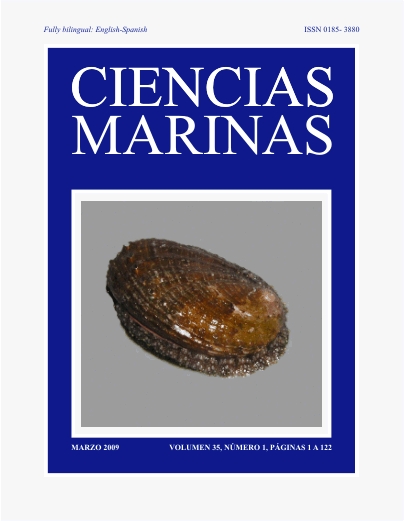Short-term size-specific distribution and movement patterns of juvenile flatfish in a Pacific estuary derived through length-frequency and mark-recapture data
Main Article Content
Abstract
Evaluating small-scale distribution and movement patterns of juvenile fishes within estuarine systems is necessary for identifying favorable nursery habitats and adequately interpreting local instantaneous growth and mortality estimates. Finescale, size-specific catch per unit effort (CPUE, catch per 500 m tow) and movement of juvenile flatfish were studied in Punta Banda Estuary, Baja California, Mexico, during the summer of 2004. After dividing the estuary into five contiguous sections, habitat utilization and movement were analyzed using two complimentary approaches. We intensively surveyed the estuary throughout the summer to document the size-specific distribution of flatfishes. California halibut and diamond turbot were captured throughout the estuary on all sampling dates, indicating that the entire system serves as habitat for juveniles. Multiple regression analysis indicated that the CPUE of California halibut was significantly and negatively related to temperature and depth, although the model exhibited low explanatory power. In contrast, the CPUE of diamond turbot was only significantly and negatively related to depth. CPUE was not related to salinity for either species. Analyses of site- and time-specific lengthfrequency distributions indicated movement by all flatfishes on the time scale of weeks, which is likely due to the estuarine emigration of fish >140 mm standard length. In addition, an estuary-wide mark-recapture study was performed. Visible elastomer implants were used to tag 697 California halibut, 442 diamond turbot, and 128 spotted turbot. Based on sectionspecific CPUE and the area of the estuary, we tagged 3–6% of the local population of each species in a given month. Four Californian halibut and two diamond turbot were recaptured within hundreds of meters of where they were released. Hence, we observed residency and movement at the same time. This study indicates that short-term movement and its underlying causes should be taken into account when assessing patterns of juvenile habitat utilization.
Downloads
Article Details
This is an open access article distributed under a Creative Commons Attribution 4.0 License, which allows you to share and adapt the work, as long as you give appropriate credit to the original author(s) and the source, provide a link to the Creative Commons license, and indicate if changes were made. Figures, tables and other elements in the article are included in the article’s CC BY 4.0 license, unless otherwise indicated. The journal title is protected by copyrights and not subject to this license. Full license deed can be viewed here.

